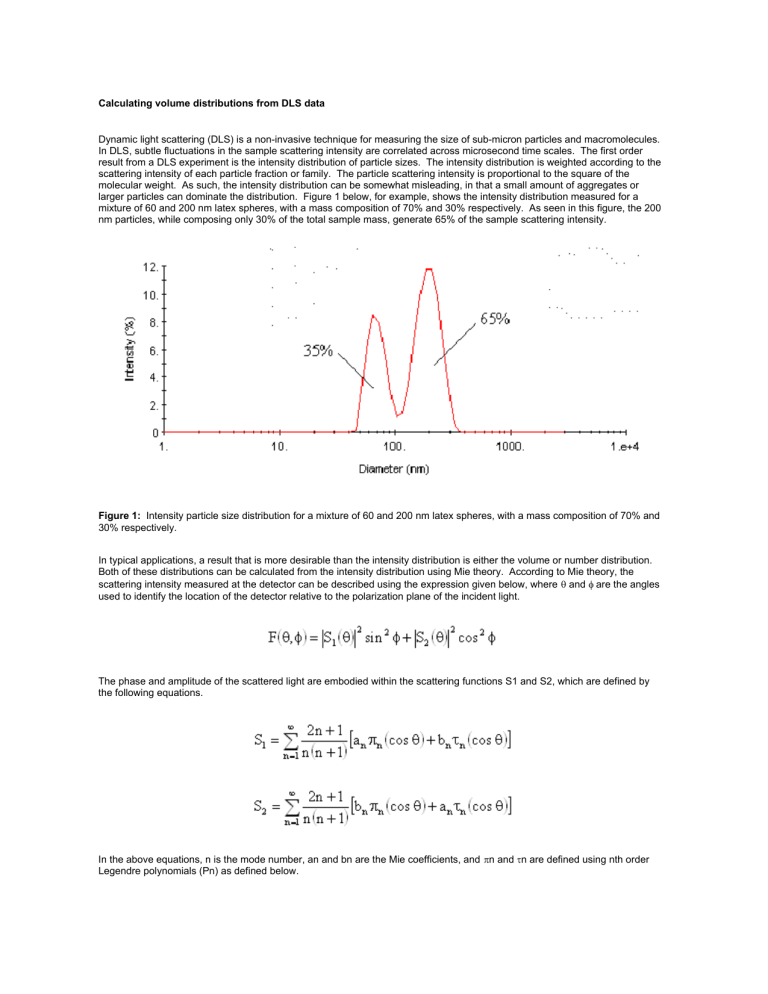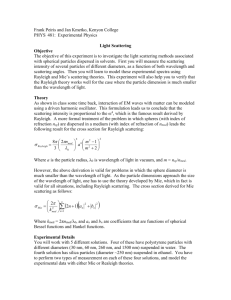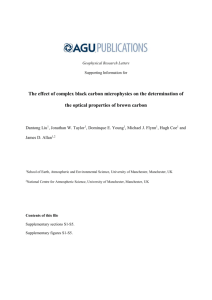Printing "Calculating volume distributions from DLS data"

Calculating volume distributions from DLS data
Dynamic light scattering (DLS) is a non-invasive technique for measuring the size of sub-micron particles and macromolecules.
In DLS, subtle fluctuations in the sample scattering intensity are correlated across microsecond time scales. The first order result from a DLS experiment is the intensity distribution of particle sizes. The intensity distribution is weighted according to the scattering intensity of each particle fraction or family. The particle scattering intensity is proportional to the square of the molecular weight. As such, the intensity distribution can be somewhat misleading, in that a small amount of aggregates or larger particles can dominate the distribution. Figure 1 below, for example, shows the intensity distribution measured for a mixture of 60 and 200 nm latex spheres, with a mass composition of 70% and 30% respectively. As seen in this figure, the 200 nm particles, while composing only 30% of the total sample mass, generate 65% of the sample scattering intensity.
Figure 1: Intensity particle size distribution for a mixture of 60 and 200 nm latex spheres, with a mass composition of 70% and
30% respectively.
In typical applications, a result that is more desirable than the intensity distribution is either the volume or number distribution.
Both of these distributions can be calculated from the intensity distribution using Mie theory. According to Mie theory, the scattering intensity measured at the detector can be described using the expression given below, where
θ
and
φ
are the angles used to identify the location of the detector relative to the polarization plane of the incident light.
The phase and amplitude of the scattered light are embodied within the scattering functions S1 and S2, which are defined by the following equations.
In the above equations, n is the mode number, an and bn are the Mie coefficients, and
π n and
τ n are defined using nth order
Legendre polynomials (Pn) as defined below.
The Mie coefficients, an and bn, are defined as shown in the following expressions, where jn and hn(1) are nth order spherical
Bessel functions, m is the refractive index of the particle from which light is being scattered, x is the size parameter (= 2
π a/
λ
),
λ is the vacuum wavelength of the incident light, a is the particle radius, and the primes denote differentiation with respect to the arguments.
Given the refractive index of the particle and the scattering angle, Mie theory can be used to calculate the scattering intensity as a function of particle size. Some examples are given in the following figure, which shows the size dependent scattering intensities for globular proteins, polystyrene latexes, and titanium dioxides, with refractive indices (real/imaginary) of 1.39/0.01,
1.59/0.01, and 2.50/1.00 respectively.
Figure 2: Comparison of the size dependent Mie scattering curves for particles of different refractive index.
Using Mie theory, the transform of the DLS intensity distribution to other types of distributions is straightforward. The intensity distribution gives us the amount of light scattered by particles in the diameter range of x to x+
∆ x, while the Mie scattering formula tells us how much a particle of a certain diameter scatters. So the number distribution can be calculated using the equation shown below, where I(x) is the DLS intensity distribution, N(x) is the number distribution, and M(x, ñD, ñP) is the Mie scattering formula with the D and P subscripts representing the dispersant and particle.
The volume distribution, V(x), is then determined using the equation shown below, which assumes a spherical model.
Using Mie theory, the original intensity distribution for a mixture of 60 and 200 nm latex spheres, with a mass composition of
70% and 30% respectively, can be transformed into the volume and number distributions shown in Figures 3a and 3b.
Figure 3a: Volume distribution, derived from the measured intensity distribution in Figure 1, for a mixture of 60 and 200 nm latex spheres, with a mass composition of 70% and 30% respectively.
Figure 3b: Volume distribution, derived from the measured intensity distribution in Figure 1, for a mixture of 60 and 200 nm latex spheres, with a mass composition of 70% and 30% respectively.
On a cautionary note, it should be recognized that transformation of the first order intensity distribution to either a volume or
number distribution assumes the absence of any error in the intensity distribution. Since the DLS technique itself has an inherent 10-15% polydispersity (or band spreading), the assumption of no error is invalid. As such, volume and number distributions derived from dynamic light scattering measurements are best used for comparison purposes or for estimating the relative amounts of multimodal (multiple size peaks) samples, and should never be considered absolute.
While the original theory developed by Gustav Mie utilized a homogeneous sphere model, the foundations of Mie ’ s work has been applied to a variety of different particle system models, such as cylinders, rods, concentric spheres, and index gradient spheres. For additional reading, the following references are recommended.
1) Mie, G. Ann. Physik 1908 , 4 , 377.
2) van de Hulst, H.C. "Light Scattering By Small Particles", Chpt 9 & 10; 1981 , Pub: Dover, New York.
3) Kerker, M. "The Scattering Of Light & Other Electromagnetic Radiation", Chpt 4; 1969 , Pub: Academic Press, New York.
4) Bohren, C.F., Huffman, D.R. "Absorption And Scattering Of Light By Small Particles"; 1983 , Pub: Wiley, New York.
5) Aden, A.L., Kerker, M. "Scattering Of Electromagnetic Waves From Two Concentric Spheres", J. Appl. Phys.
1951 , 22 ,
1242.
6) Kai, L., d ’ Dlessio, A. "Extinction Efficiency Of Gradient-Index Microspheres", Particles and Particle Systems Characterization
1995 , 12 , 119.
For additional questions or information regarding Malvern Instruments complete line of particle and materials characterization products, visit us at http://www.malverninstruments.com/ .







